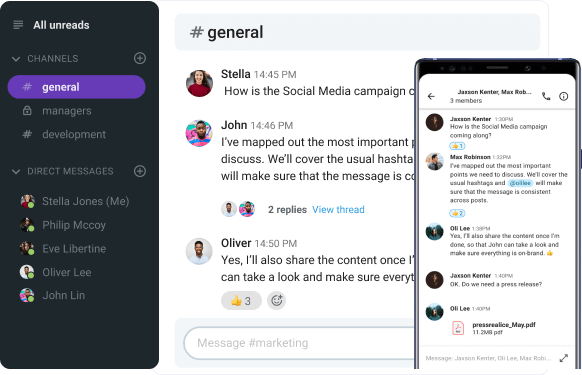If you’re tired of losing money and focus on run-of-the-mill communication apps like Slack and Microsoft Teams, I can relate.
These platforms are expensive to begin with, and it doesn’t take long until you need a feature hidden behind a paywall. And just like that, it’s time to dig into your pockets and pay for another upgrade.
Because of this, for the last few years, I’ve been using Pumble, an app where work feels simple and small teams can avoid hidden fees. Recently, I’ve also seen chatter about another app catering to remote and hybrid teams — Chanty — and wanted to see how the platforms compare.
Pumble is an up-and-coming Slack alternative boasting:
- A sleek user interface with no learning curve,
- Unlimited message history, and
- Outstanding customer service.
Chanty also brings a solid feature set which includes a built-in task manager and unlimited messaging history.
So, what happens in a Pumble vs Chanty run-in? Which should you pick as your new, easy-to-use digital collaboration hub?
Let’s find out!

Pumble vs Chanty: Features comparison
Pumble and Chanty help small businesses escape endless paid upgrades found in many popular team chat apps. But does either have a free plan that can support growing teams?
Pumble does, offering unlimited message history and users even on the free plan.
On the other hand, Chanty provides a unique feature usually missing from similar software — a centralized Kanban board for task management.
Both apps prioritize no-fuss business communication — it just comes down to picking the one that doesn’t put unnecessary limits on your team.
The main differences between Pumble and Chanty are the:
- Price: When billed annually, Pumble’s pricing starts at $2.49 per month, compared to Chanty’s $3.
- Free plan constraints: Both have an unlimited, searchable messaging history, plus 1:1 voice and video calls. However, Chanty’s free plan has a hard limit of a maximum of 5 users.
- Call quality: Users can enjoy glitch-free audio and video calls in Pumble. Chanty has similar features, but the call quality can sometimes be unreliable.
The below table summarizes our Pumble vs Chanty comparison.
| Features | Pumble | Chanty |
|---|---|---|
| Pricing | — FREE (unlimited users & message history) — PRO: $2.49/user/month — BUSINESS: $3.99/user/month — ENTERPRISE: $6.99/user/month | — Free (up to 5 users) — Business: $3/user/month — Enterprise: Contact sales |
| Interface | — Familiar and intuitive — Customizable sidebar and themes | — Simple — Limited customization options |
| Communication features | — Channels — Threads — Mentions and reactions — Pinned and saved messages — Video conferencing and audio calls — Voice and video messages | — Public and private chats — Channels — Voice messages — Scheduled and disappearing messages — Voice and video calls |
| Task management | Available via Plaky integration | Built-in features: Kanban board & Teambook |
| File sharing and storage | — FREE: 10 GB per workspace — PRO: 10 GB per user — BUSINESS: 20 GB per user — ENTERPRISE: 100 GB per user | — Free: 20 GB per team — Business: 20 GB per user — Enterprise: Custom storage |
| Integrations | — Core apps like Gmail, GitHub, Google Calendar, Zapier — Clockify and Plaky | Popular integrations include Zapier, Google Drive, OneDrive, YouTube |
| Support | 24/7 on all plans (email, phone, chat) | — Community support (on the free plan) — 24/7 (on paid plans) |
| Security | Advanced | Standard |
Now, it’s time for the feature-by-feature deep dive.
Pumble vs Chanty: Pumble’s free plan feels complete, not limiting
One of the first things we examine when choosing a workplace communication app is the pricing.
So, which is cheaper, Pumble or Chanty? The short answer is Pumble, although both apps have free and paid plans.
Pumble’s no-cost plan has solidified its position as a powerful free Slack alternative, as it provides:
- Unlimited users and message history,
- 10 GB of storage per workspace, and
- Data importing from Slack.
When transitioning from Slack to Pumble a few years ago, I was pleasantly surprised to find many of Slack’s paid features available in Pumble for free.
Unhappy with Slack? Try Pumble
Should you decide to scale your team with Pumble, the PRO plan costs $2.49 (billed annually) and unlocks:
- Group calls (voice and video),
- More integrations,
- Screen sharing, and more.
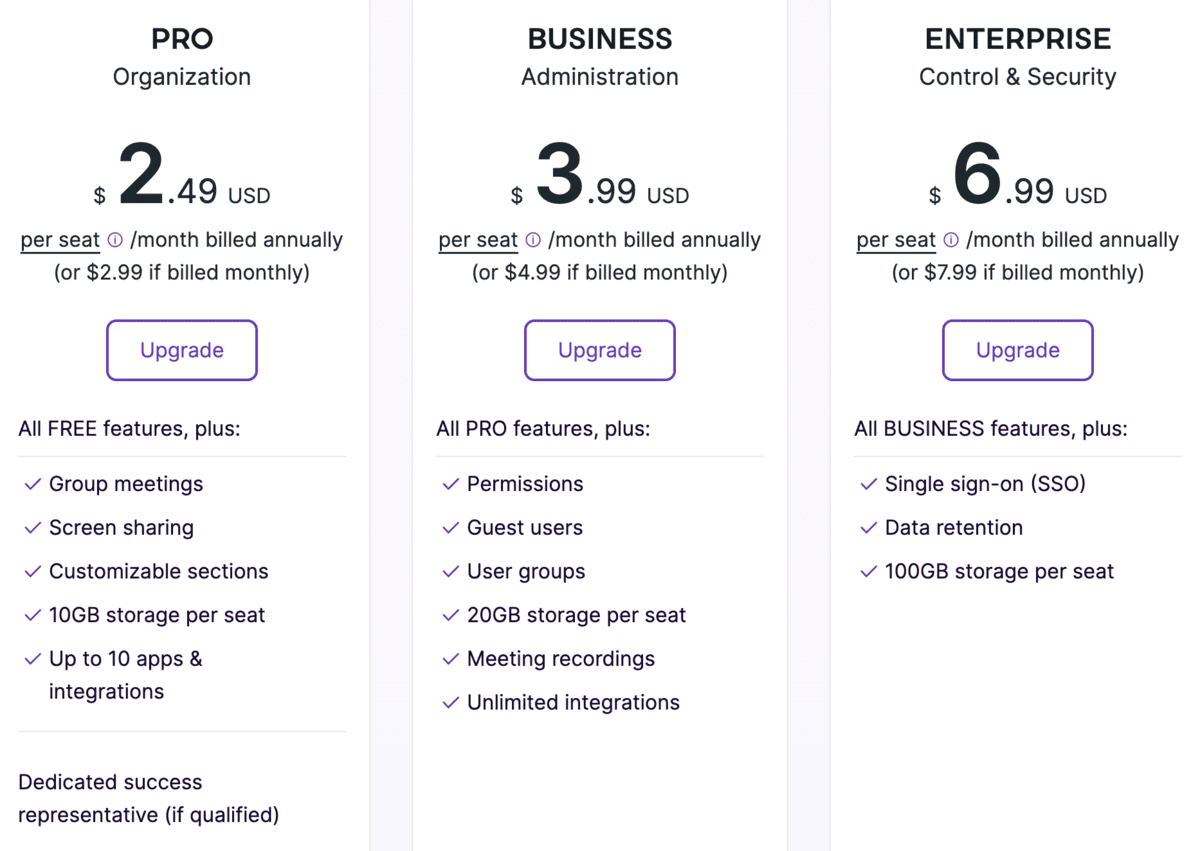
Pumble has two additional plans:
- BUSINESS: Priced at $3.99, it includes Pumble features from the PRO plan, plus meeting recordings, 20 GB of file storage per user, guest access, and more.
- ENTERPRISE: Costs $6.99, and, besides having access to features from the BUSINESS plan, users can manage access using single sign-in (SSO) and enjoy 100 GB of cloud storage per seat.
Turning to Chanty, if your small team is just starting out, the free plan might help, offering:
- Up to 5 team members,
- Unlimited private and public chats, and
- Searchable messaging history.
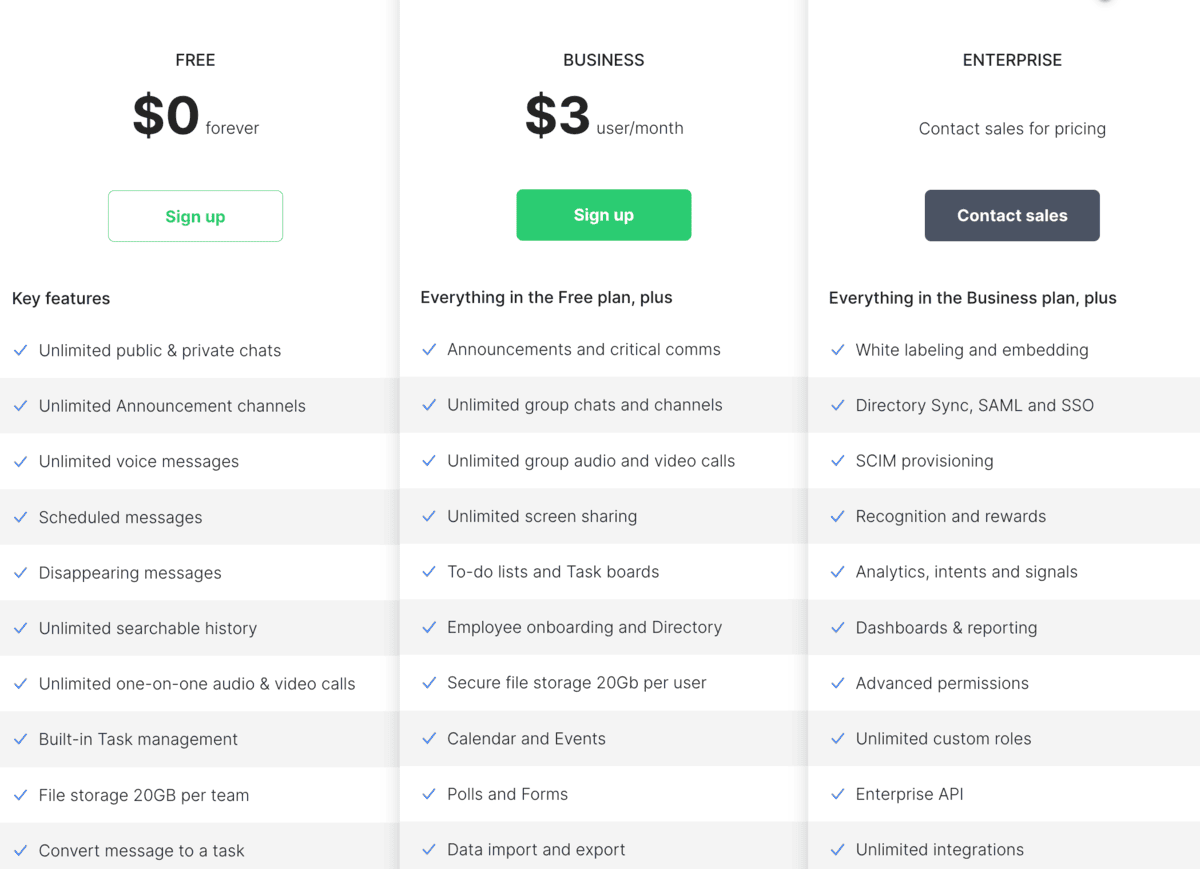
Like Pumble, Chanty offers unlimited message history across all plans. Although, once you’re ready to scale beyond 5 team members, the free plan can feel stifling. You could opt for one of the paid tiers:
- Business: Priced at $3 per user per month (billed annually), it comes with additional Chanty features, including audio and video conferencing and group channels and messaging.
- Enterprise: Pricing is available upon inquiry, and this subscription brings users custom permissions, advanced dashboards and reporting, and custom data retention policies.
Both apps are affordable, with Pumble coming out on top as the more budget-friendly option. Moreover, if you’re happy with the free version, you can enjoy its perks and invite new members at no extra cost.
💡 PUMBLE PRO TIP
Need a collaboration tool that lets you connect with more than 5 users for free? Head below to discover the best option:
Pumble vs Chanty: Chanty has an incredibly simple UI
When it comes to the user interface, both apps have an uncomplicated design.
Chanty’s basic design flattens the learning curve for new users. If Chanty is your introduction to asynchronous communication software, you’ll probably have no problem getting into the swing of things.
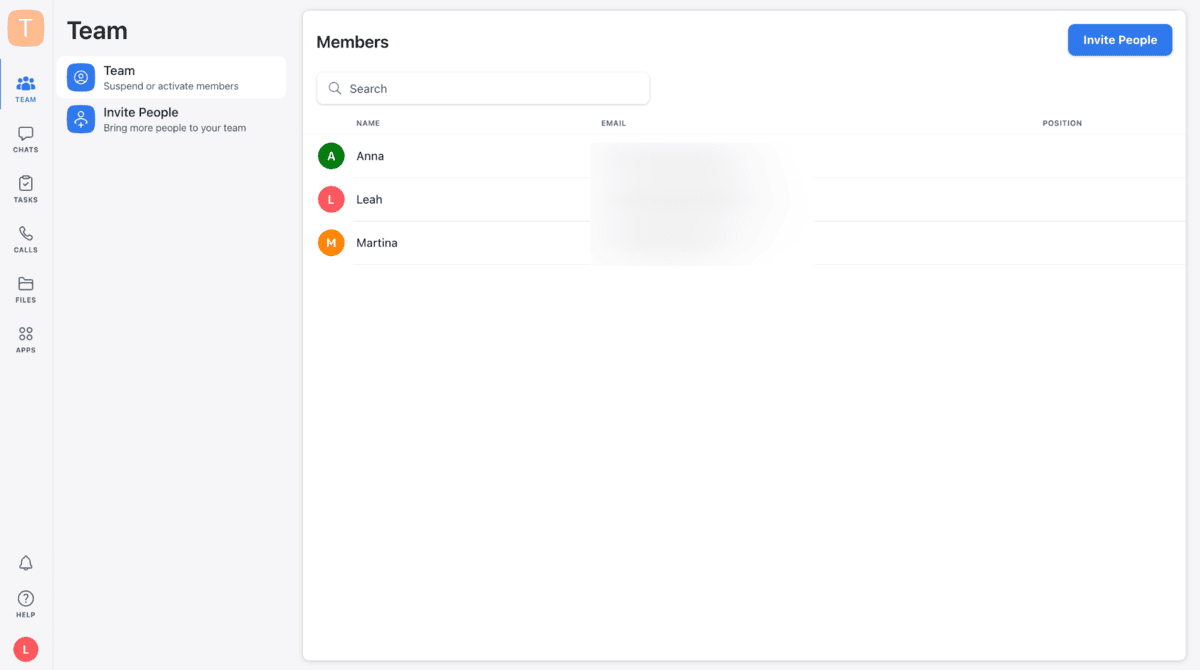
After completing the registration process, which only took a few minutes, I was presented with the left-hand section of the app, where I found my:
- Team, which allows me to manage team activity, invite new members, and suspend or activate users,
- Chats, with conversations that are either private, involving select team members, or public, with new members added automatically when they join the workspace,
- Tasks, which gives me the option to organize my tasks into columns and categorize them how I see fit,
- Calls, to make phone calls from within the app,
- Files, which gives me an overview of shared files in either Table or Card view, and
- Apps, which allow me to quickly find available and installed integrations.
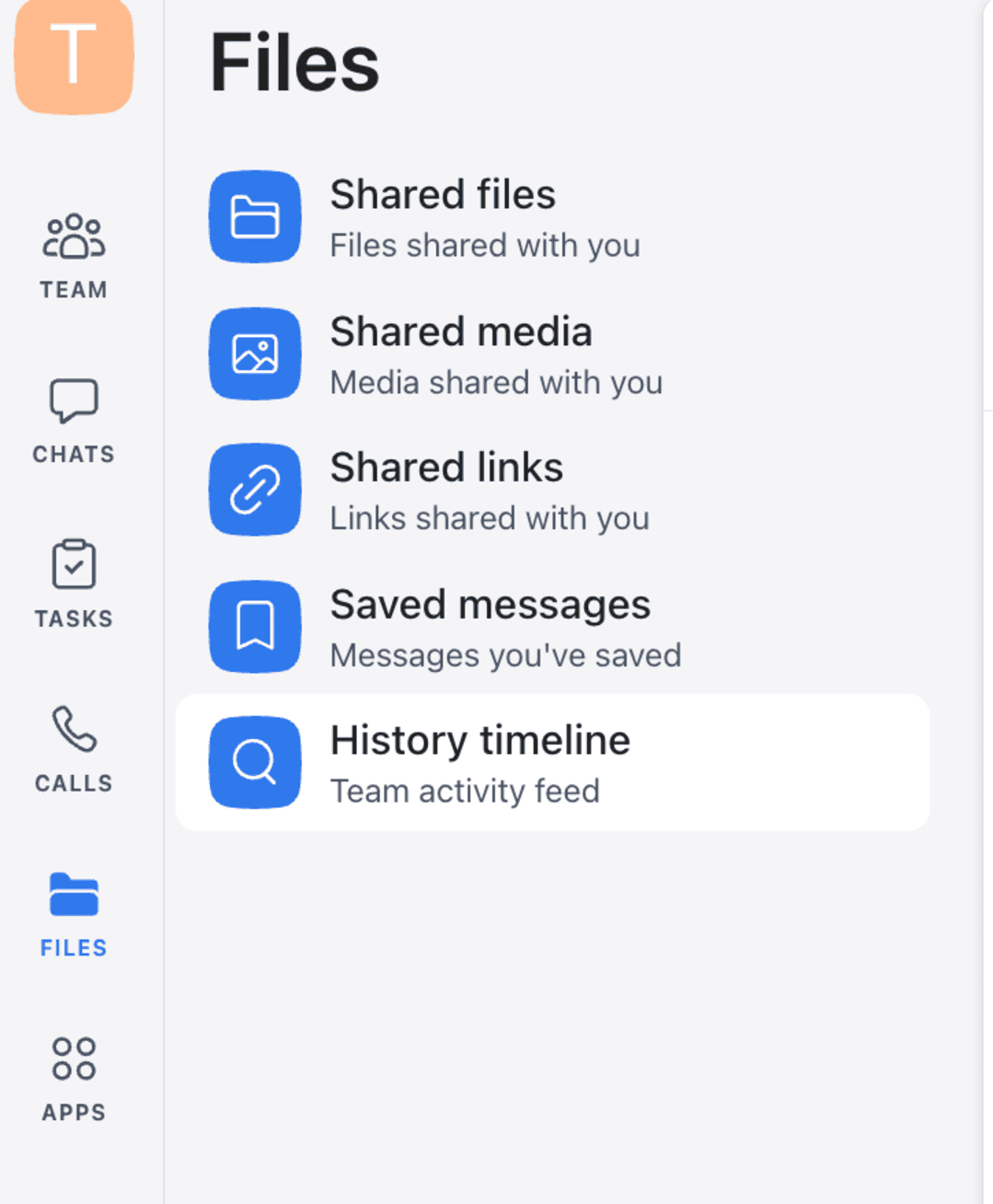
The layout is much simpler than Microsoft Teams’, for example, so finding what you need takes no time at all — a big plus in my book.
The downside is that you might find the interface slightly unappealing, especially if you’re already used to a specific look of internal communication apps.
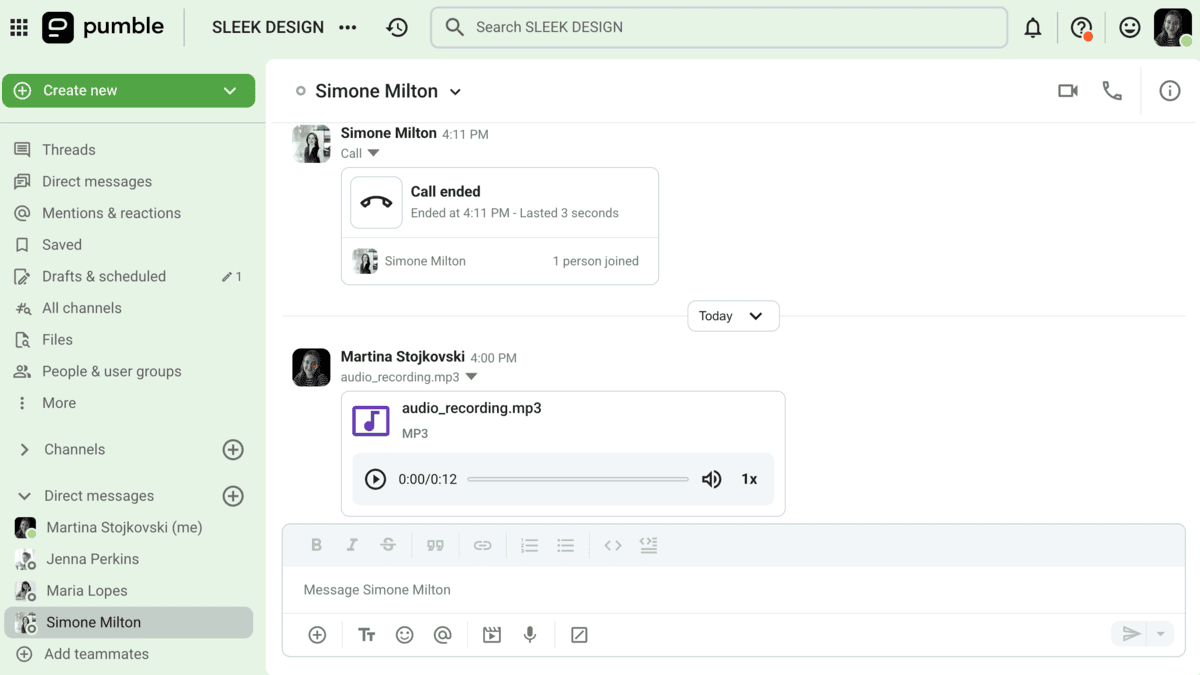
Pumble also keeps its UI simple while having a design that feels intuitive and familiar. Using the customizable sidebar is straightforward, and I always have a clear picture of my:
- Channels,
- Mentions and reactions,
- Threads, and
- Direct messages.
The logical layout keeps my workspace clutter-free and eliminates the need for long, drawn-out employee onboarding — at least it did for me. The design choices bring team communication into focus, rather than overly complex features.
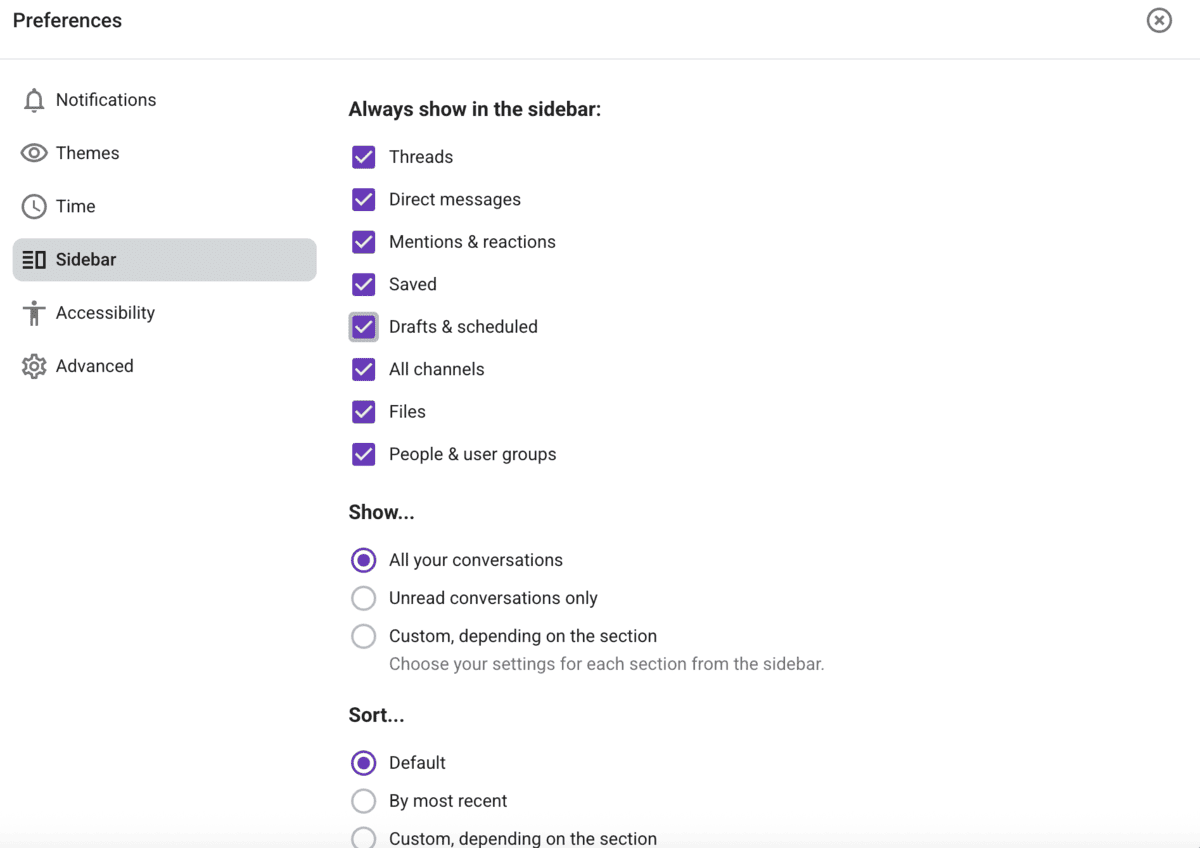
In my opinion, Chanty’s barebones simplicity makes sense for non-technical teams. Conversely, Pumble’s interface makes it possible to keep track of multiple teams and projects with greater ease.
💡 PUMBLE PRO TIP
Our comparison focuses solely on Pumble and Chanty. However, you might be curious how these apps compare to other collaboration tools. How would a Pumble vs Slack vs Chanty comparison turn out? Are there effective Chanty alternatives you’re yet to find? For all this and more, check out this page:
Pumble vs Chanty: Pumble is a more well-rounded communication app
Speaking of team communication, that’s where Pumble shines.
I find threads particularly useful, especially in tandem with public and private channels. Each team or project can have a dedicated channel, keeping your digital HQ tidy and organized.
Going a step further, threads neatly sort all relevant replies beneath the original message, so your team discussions won’t spill out to the rest of the channel.

You can further streamline your communication with:
- Pinned and saved messages,
- Reminders,
- Emoji reactions, and
- Scheduled messages.
The ability to schedule a message is a lifesaver if you’re managing employees or freelancers working across time zones.
I was happy to see Chanty offers similar functionalities, including:
- Team chat,
- Channels,
- Threads,
- Message editing and formatting, and
- Saved messages.
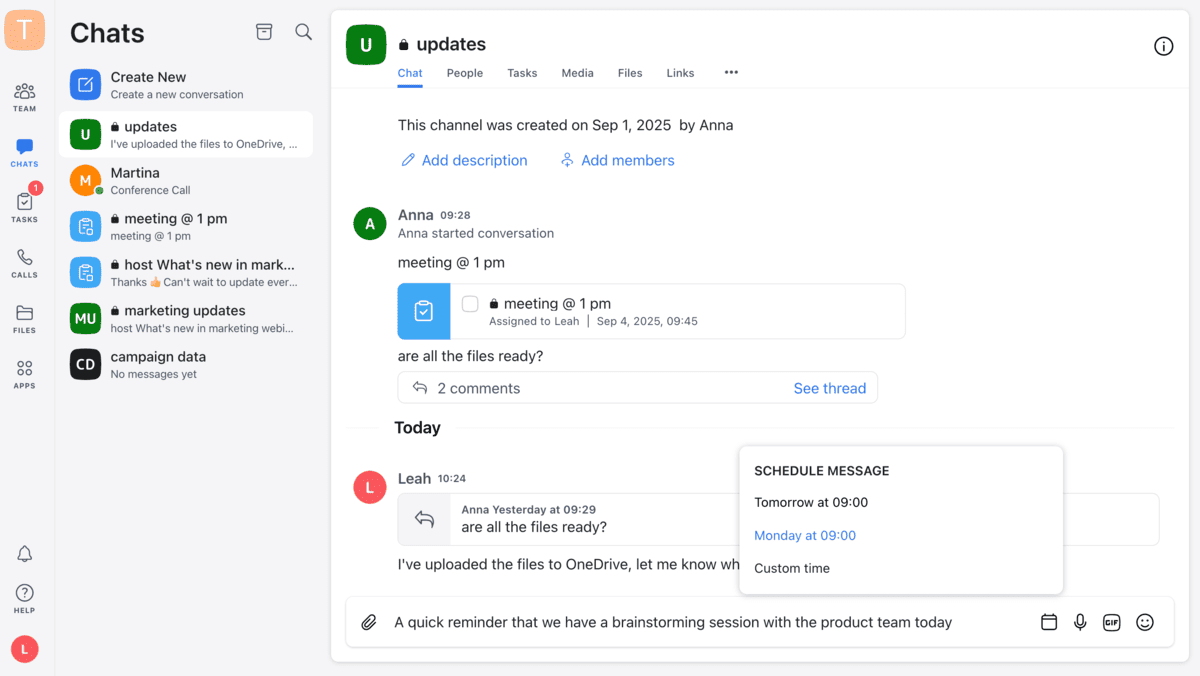
One thing that stood out to me in Chanty is that both DMs and channels are grouped together in the Chats subsection. Most business messaging apps separate messages and channels for greater convenience, which is a layout that works best for me. Still, once I got used to this design choice, there was no confusion or aimless scrolling.
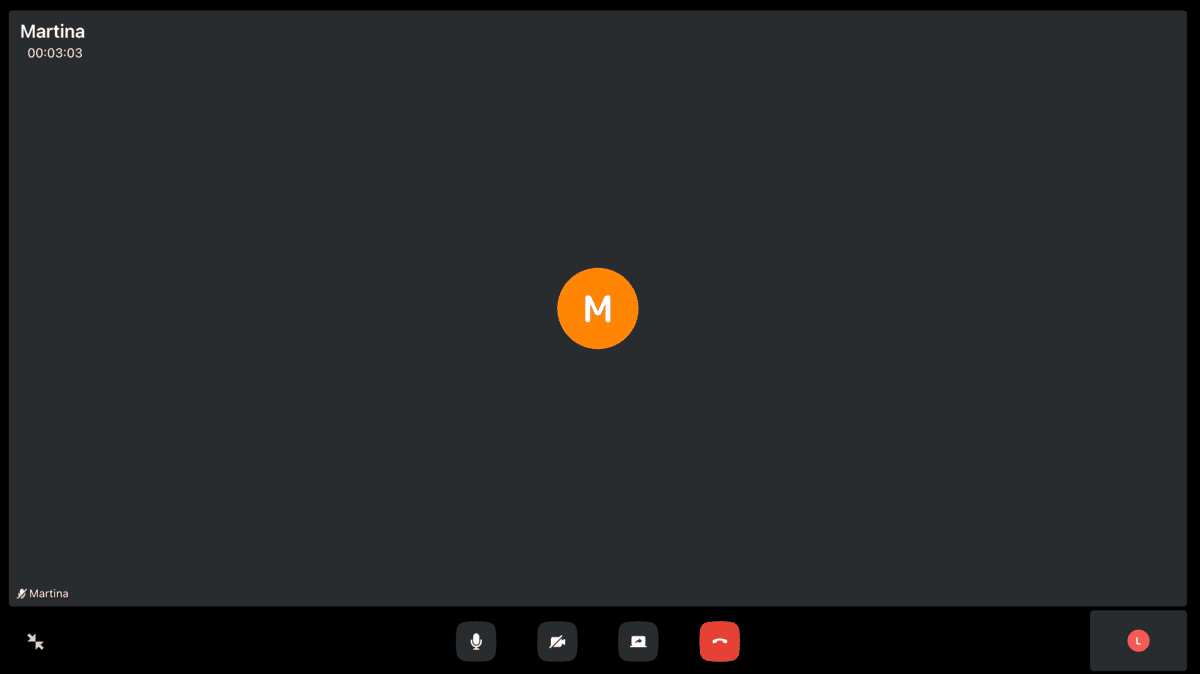
It’s obvious that Chanty began as a messaging-first platform, but I would have liked to see a “Settings” button and in-meeting chat during 1:1 video calls. I could share my screen and disable the audio and video feeds — that was it.
Pumble also includes 1:1 video calls in the free plan, and the “Settings” button is clearly visible. This allows me to quickly switch between cameras and microphones. More importantly, I can send in-meeting messages to share links or insights.
Run effective meetings in Pumble
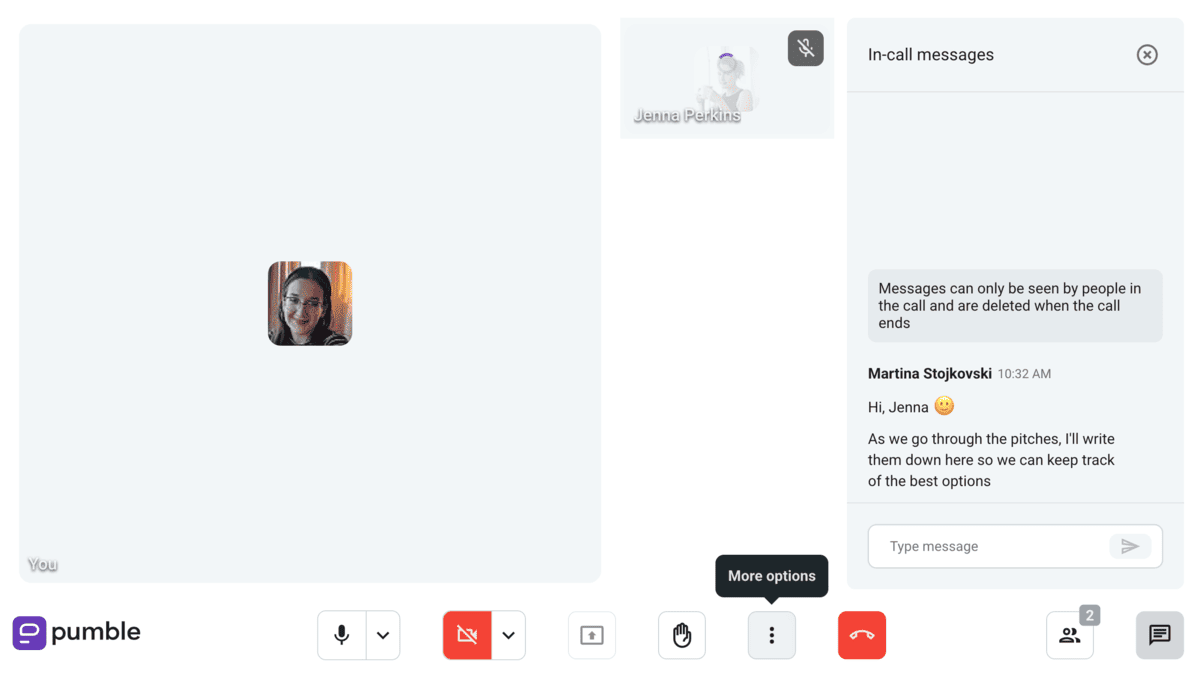
Ultimately, both apps have the features necessary for simple, efficient communication. Teams that don’t hold many meetings can choose either. Organizations with more frequent meetings should probably pick Pumble for a better video calling experience.
💡 PUMBLE PRO TIP
Looking for a new collaboration tool or a comprehensive team communication app? Head to this roundup to see our top picks:
Pumble vs Chanty: Chanty brings built-in task management features
In terms of project and task management, Chanty boasts more native features than Pumble.
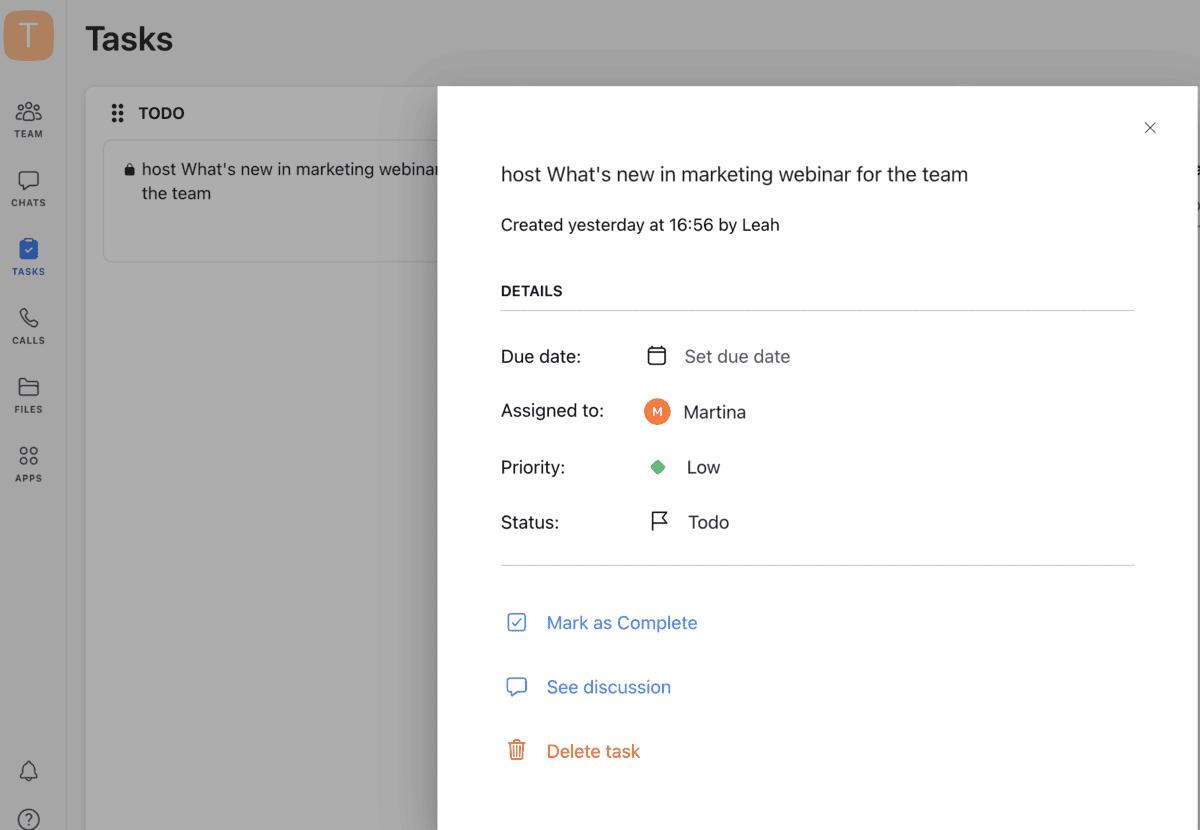
I was able to access these features on the free plan, which was a plus, and had no trouble:
- Turning messages into tasks,
- Switching between Kanban and List view,
- Assigning tasks to team members, and
- Tracking activities through my History timeline.
I could also send code snippets using Chanty’s code editor, which was a nice touch. The editor reportedly supports over 50 programming languages and might help with your first serious coding project.
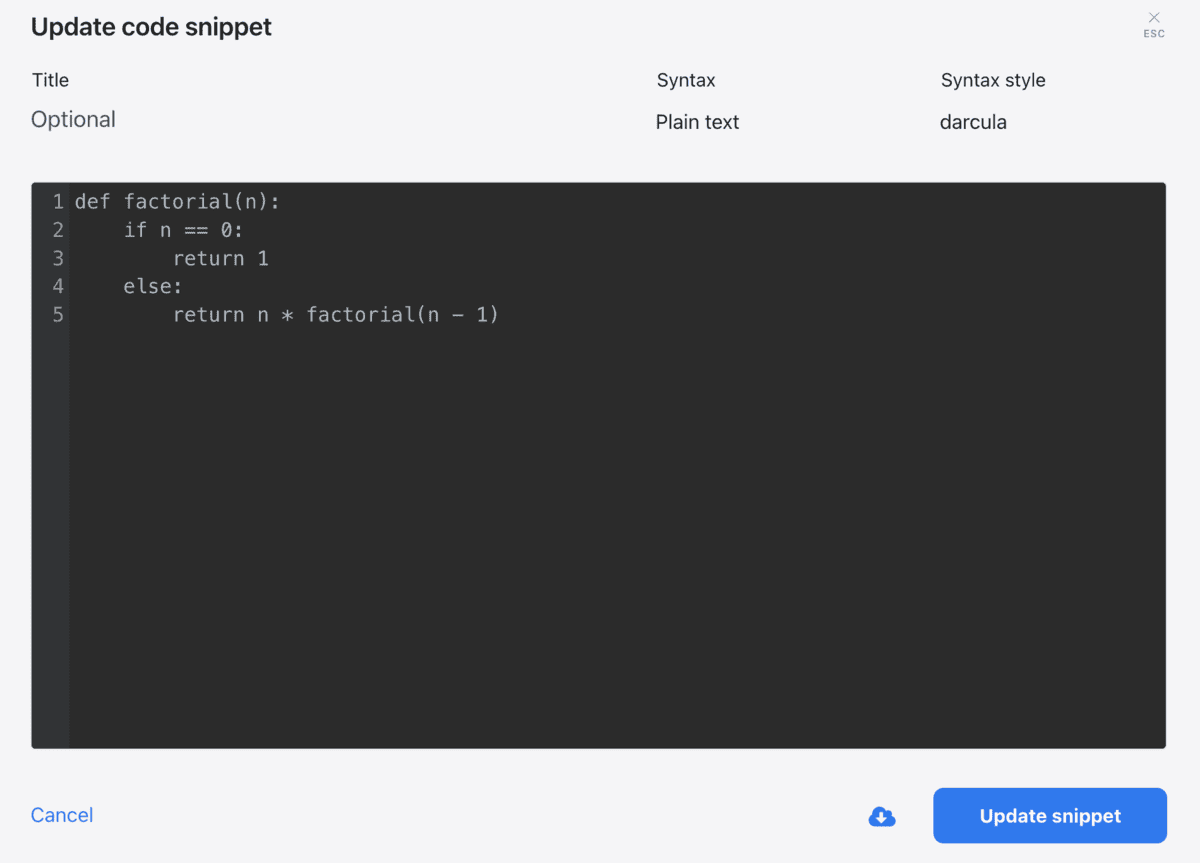
Are these Chanty features useful? Definitely. Is this enough to completely eliminate the need for full-fledged project management software? Probably not.
Unlike Chanty, Pumble features don’t extend into task management — Pumble covers that via its free integration with its sister software, Plaky.
This lack of built-in capabilities doesn’t mean you can’t manage a project in Pumble from start to finish.
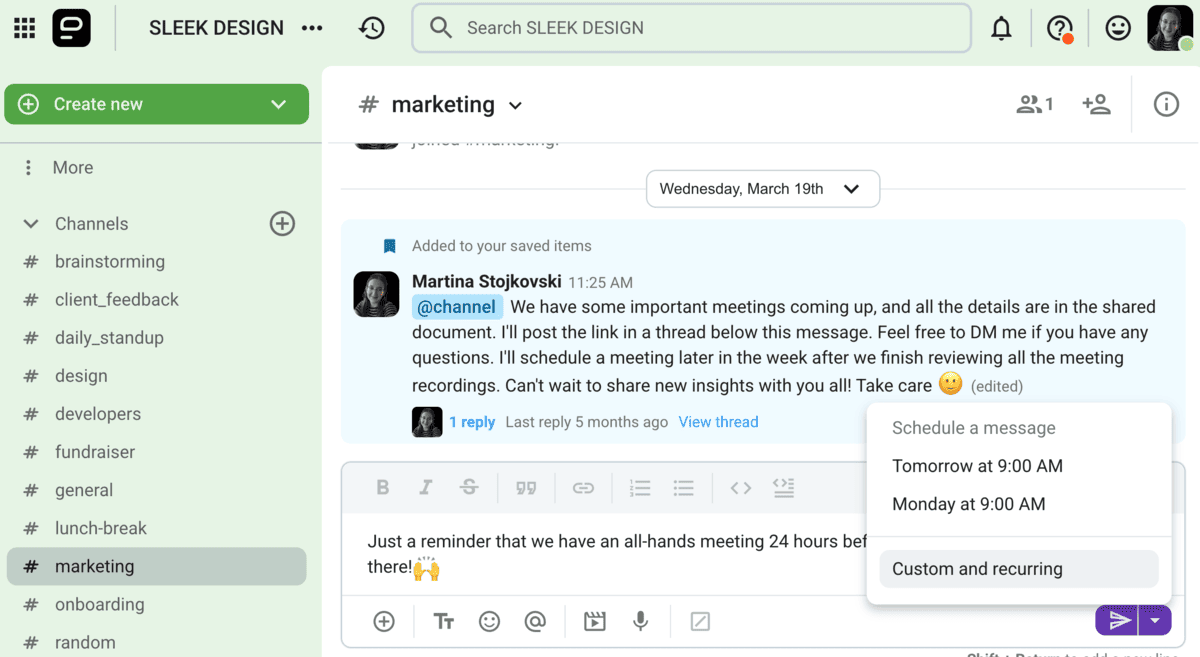
I personally like to keep track of to-dos with:
- Recurring messages — This Pumble feature is perfect for sending reminders, organizing project updates, and setting up standup meetings.
- Saved messages — Use saved items as reminders or come back to them at a more convenient time.
- My DM space — Turn this space into a personal to-do list and get a clearer overview of your day or week.

In the end, Chanty’s features in this category are nice to have, but they won’t expedite workflows for highly technical teams that handle product development, for example.
Pumble, although without native task management features, can be used effectively for task organization. For more demanding work, Pumble pairs up nicely with Plaky and other integrations.
Save money & get Pumble + Plaky + Clockify
Pumble vs Chanty: Chanty has limited integrations while Pumble has access to a growing marketplace
Both Pumble and Chanty integrate with a select number of third-party apps. I don’t mind having a narrower choice since adding too many integrations can quickly lead to workplace distractions.
The question is, how much can you achieve with the integrations available to you in each app?
Right off the bat, you’ll notice that Chanty has multiple integrations preinstalled, including:
- Zapier,
- Google Drive,
- Dropbox, and
- OneDrive.
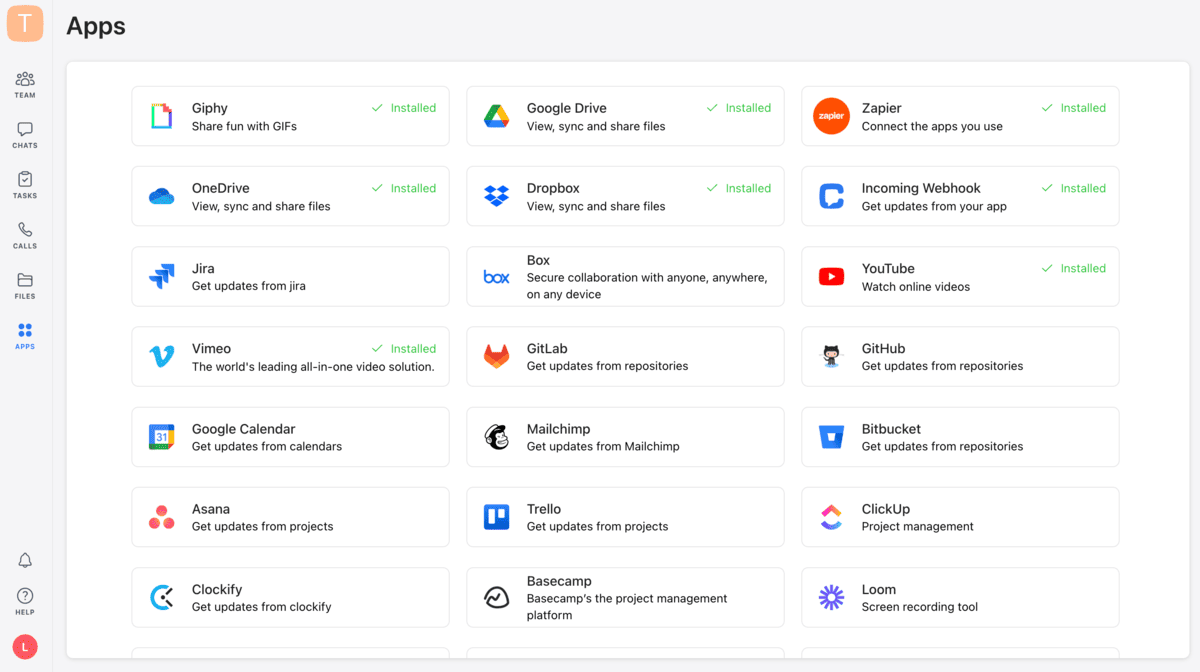
In theory, you can use Zapier to connect Chanty to thousands of apps and automate parts of your workflows. But, most of the available integrations in Chanty focus on productivity and file management.
It would be nice to see some variety, with a handful of integrations covering multiple categories. Should you decide it’s worth going for a paid plan, you can reach out to Chanty and request a custom integration.

Similarly to Chanty, Pumble doesn’t overwhelm users with an abundance of third-party options. Some of its core integrations include:
- Gmail,
- Calendly,
- GitHub, and
- Zapier.
However, what makes Pumble stand out from other communication software is that it’s part of the Productivity Bundle by CAKE.com. This means it integrates seamlessly with Clockify and Plaky.
So, with only 3 tools, you can cover time tracking, project management, and employee communication.
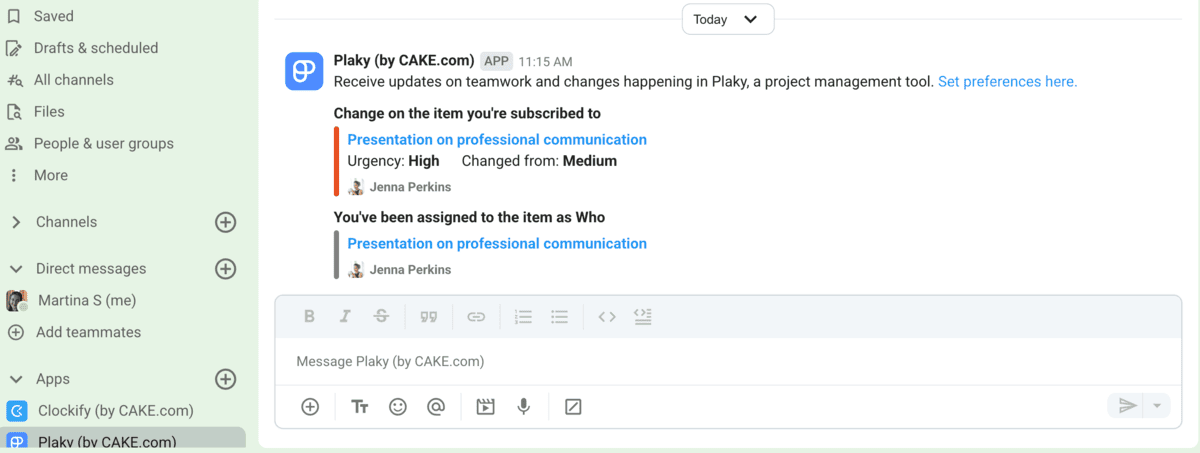
Instead of splitting my screen to keep an eye on tasks in Plaky and messages in Pumble, I receive updates directly in my inbox. Thanks to this convenience, I don’t waste time wondering what’s happening with a task or project — I get to follow along every step of the way, without closing Pumble.
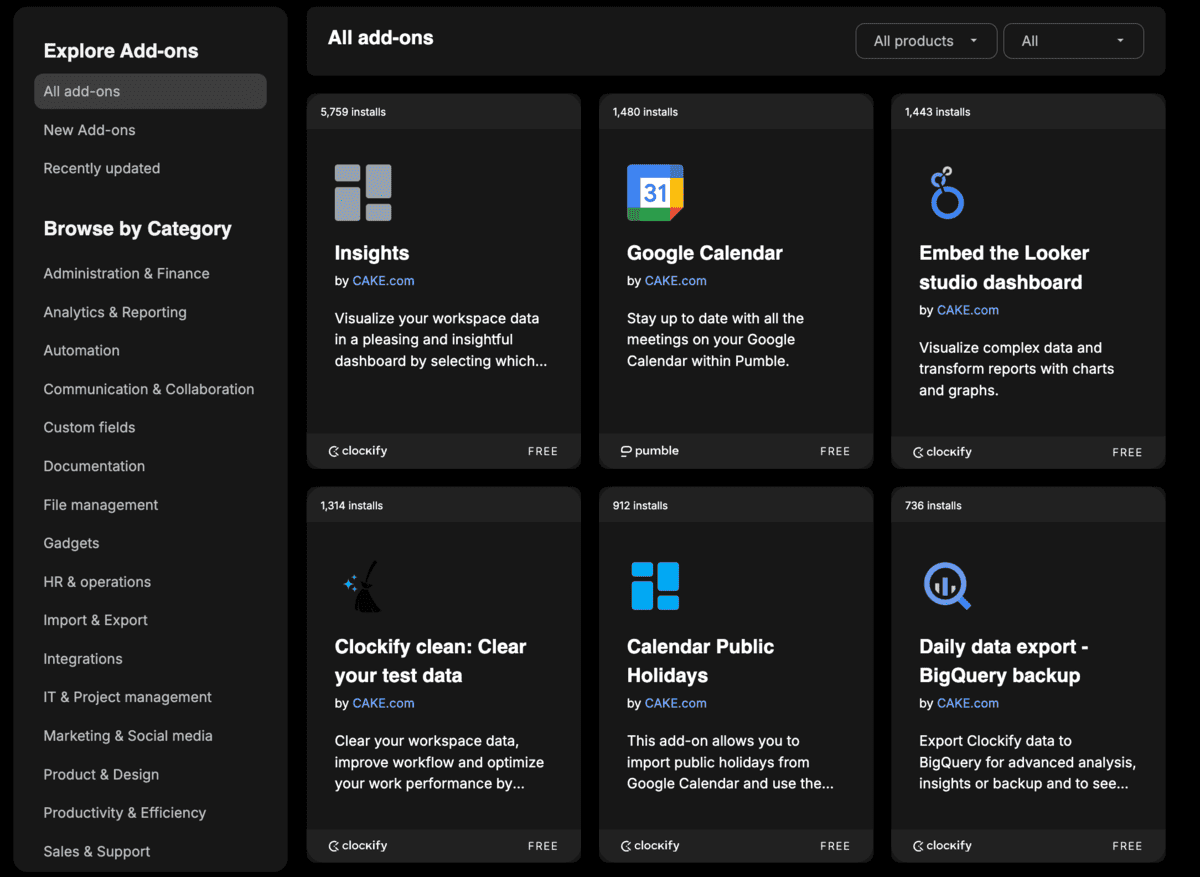
Another perk is the CAKE.com Marketplace, where you can access additional integrations or even upload your own add-ons. I’ve rarely seen this level of customization in similar team communication tools.
Build your own add-ons in Pumble
Unless you use multiple apps everyday, Chanty likely has everything you need. If you want to power your growth with custom add-ons, Pumble greatly smooths out the process.
💡 PUMBLE PRO TIP
For more information on how to organize work, track progress, and connect your team with the CAKE.com Bundle, check out this page:
Pumble vs Chanty: Pumble has outstanding 24/7 customer support
Whether you’re on the free or paid plan, you deserve stellar customer support. Otherwise, your user experience crumbles.
Chanty provides support across all plans, but the level of priority and care users will receive may differ.
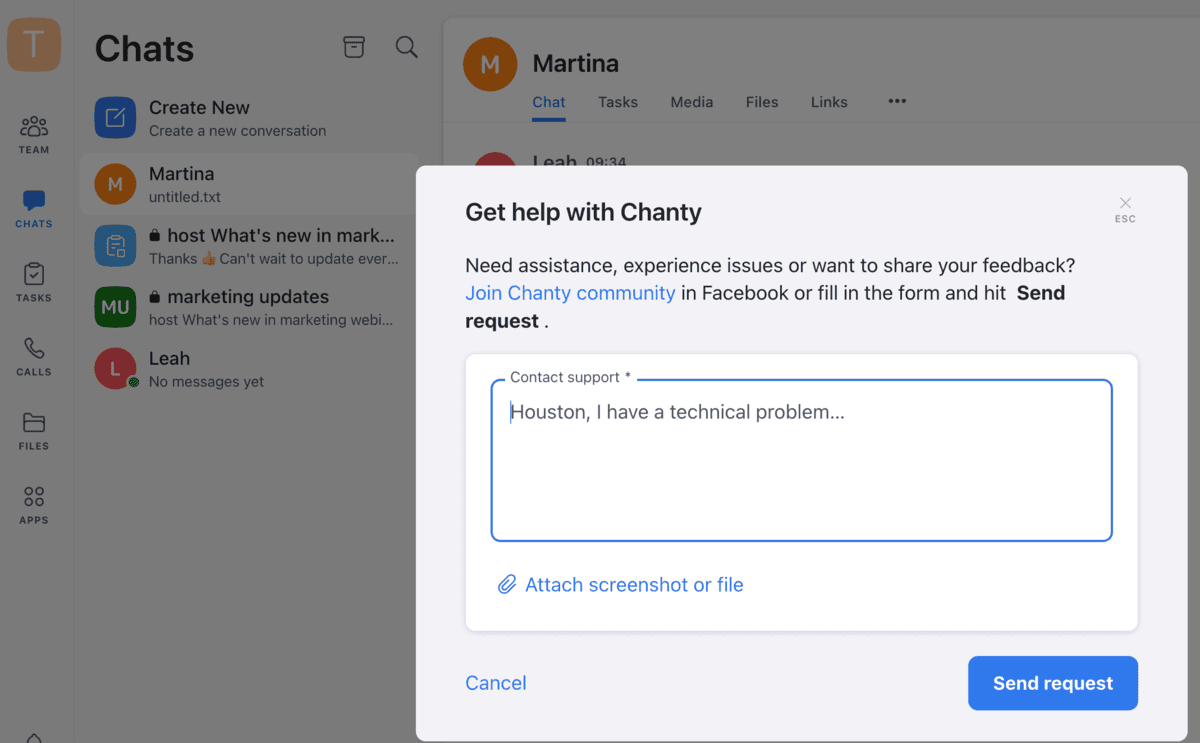
Community support is available on the free plan, so you can resolve issues by submitting a ticket or browsing Chanty’s help pages. Submitting a ticket takes no time at all, although the Help Centre isn’t as extensive as I would have hoped.

The Help & Support button also has a link to a Facebook community help group, but the group seems to be inactive, with no updates in recent months.
Business plan users have access to a 24/7 support line, while enterprise users get a:
- Dedicated support line,
- Service-level agreement, and a
- Customer success manager.
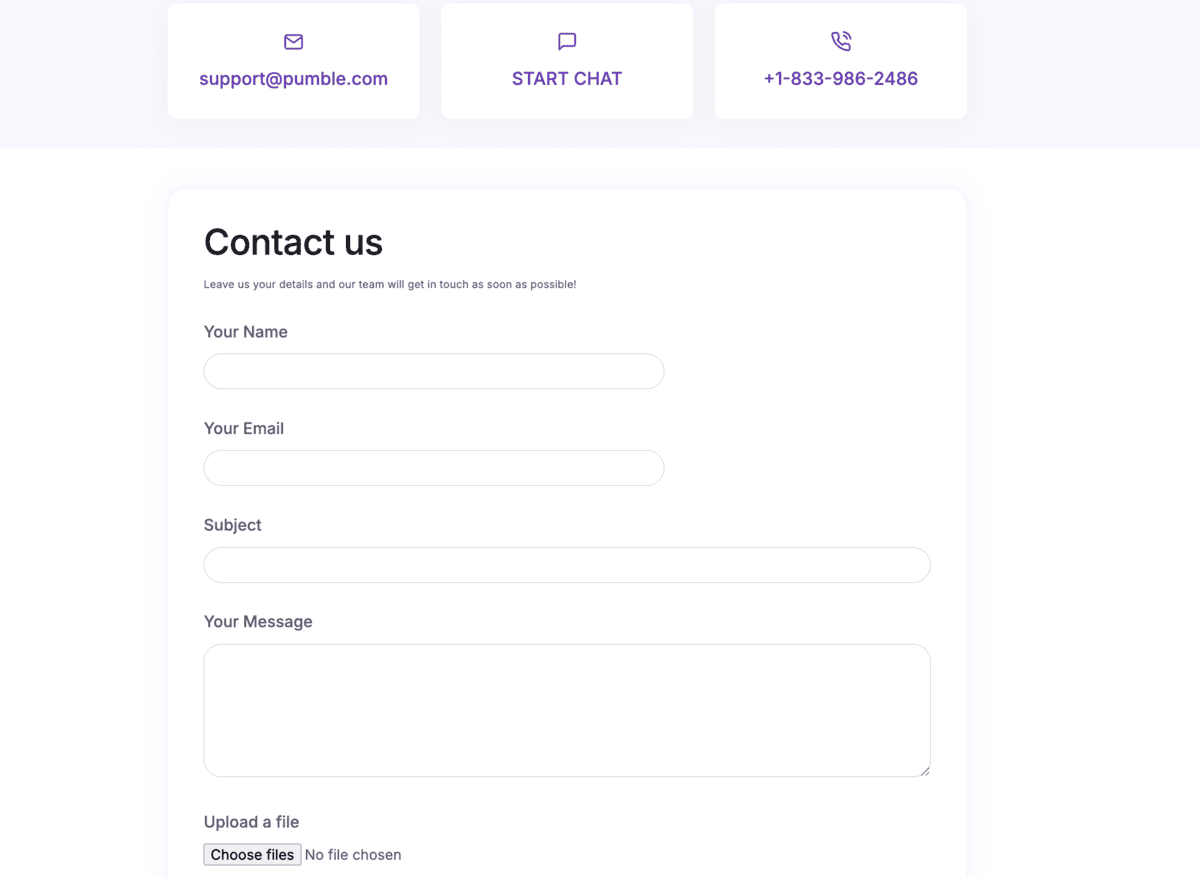
Submitting a problem ticket doesn’t always cut it, which is why Pumble has several ways users across all plans can ask for support. In addition to the exhaustive help pages, you can reach a support agent via phone or email, any time of day and night.
I personally get frustrated when AI bots give me the run around. Knowing that another person is on the other end, trying to resolve my issues, is reassuring.
As a result, Pumble takes the lead here.
Receive human customer support in Pumble
Pumble vs Chanty: Chanty lets you invite guests on the free plan
While only 5 people can be part of your free Chanty workspace, you can upgrade your knowledge and information sharing strategies by inviting 2 guest users.
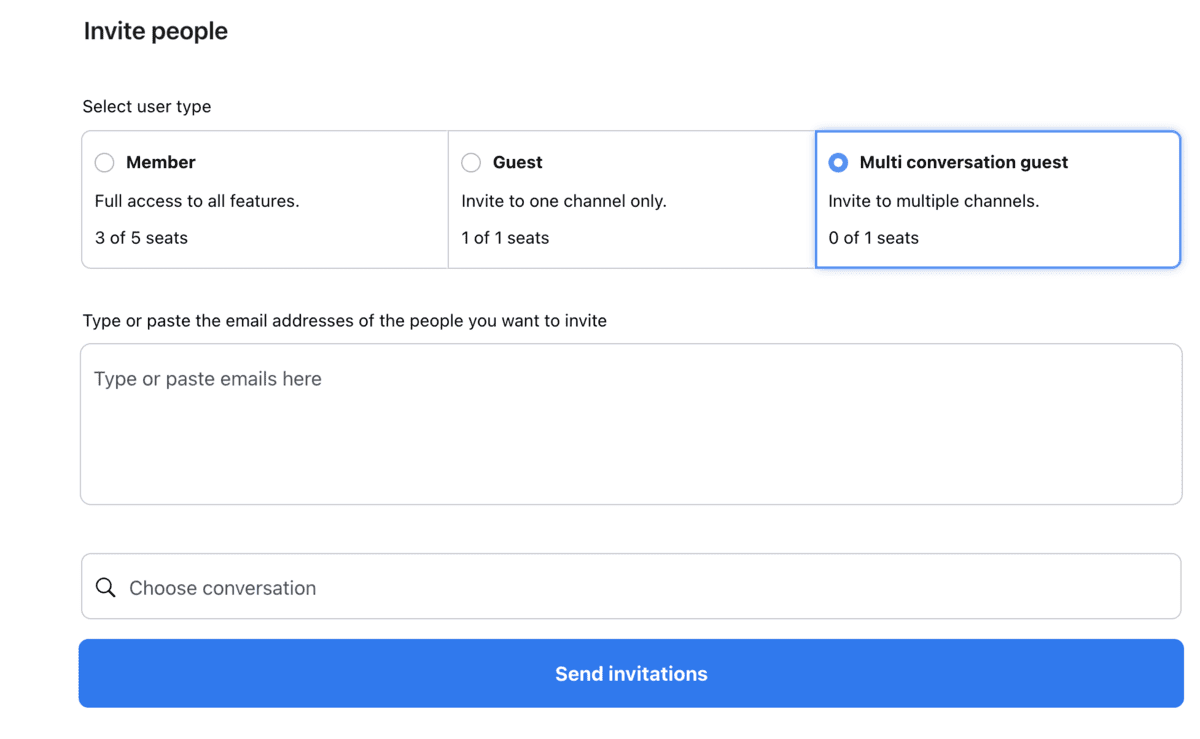
You can add 1 single-conversation guest and restrict their access only to the channel you’ve selected. Clients, customers, and contractors don’t need to know every nook and cranny of your organization and can stick to chats that pertain to them.
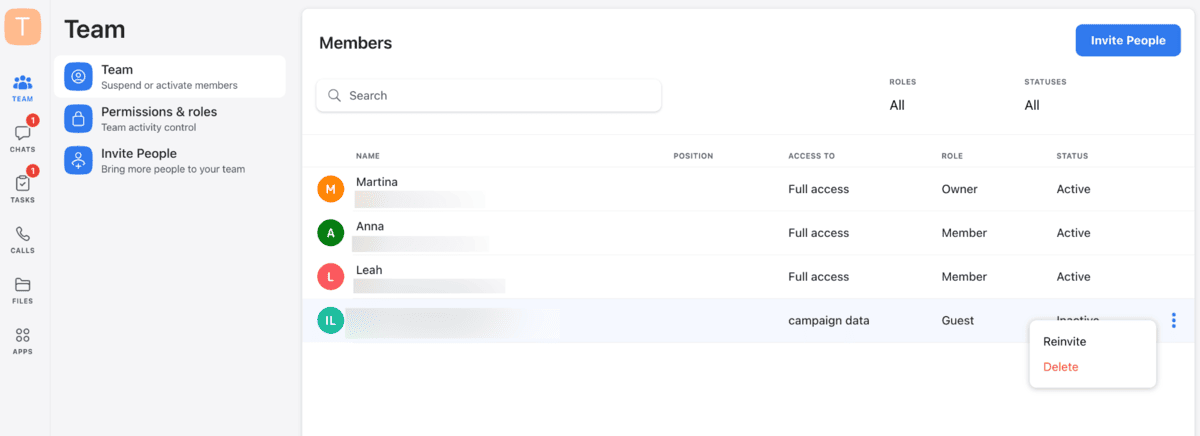
As you’ve probably guessed, multi-conversation guests have more access to your workspace. This Chanty feature works best for teams that occasionally need to bring in a consultant or contractor.
Inviting guests is a breeze, although I had to manually remove these accounts once they were no longer needed. The Business plan seems more suitable for businesses with multiple external collaborators, as it offers 3 guest accounts per member.
Moving onto Pumble, the app also categorizes guest accounts into single-channel and multi-channel guests. Thus, you have full control over what invited guests get to do and access in your digital space.

For every paid user, you can invite up to 5 single-channel guests for free, while multi-channel accounts are billed as regular users.
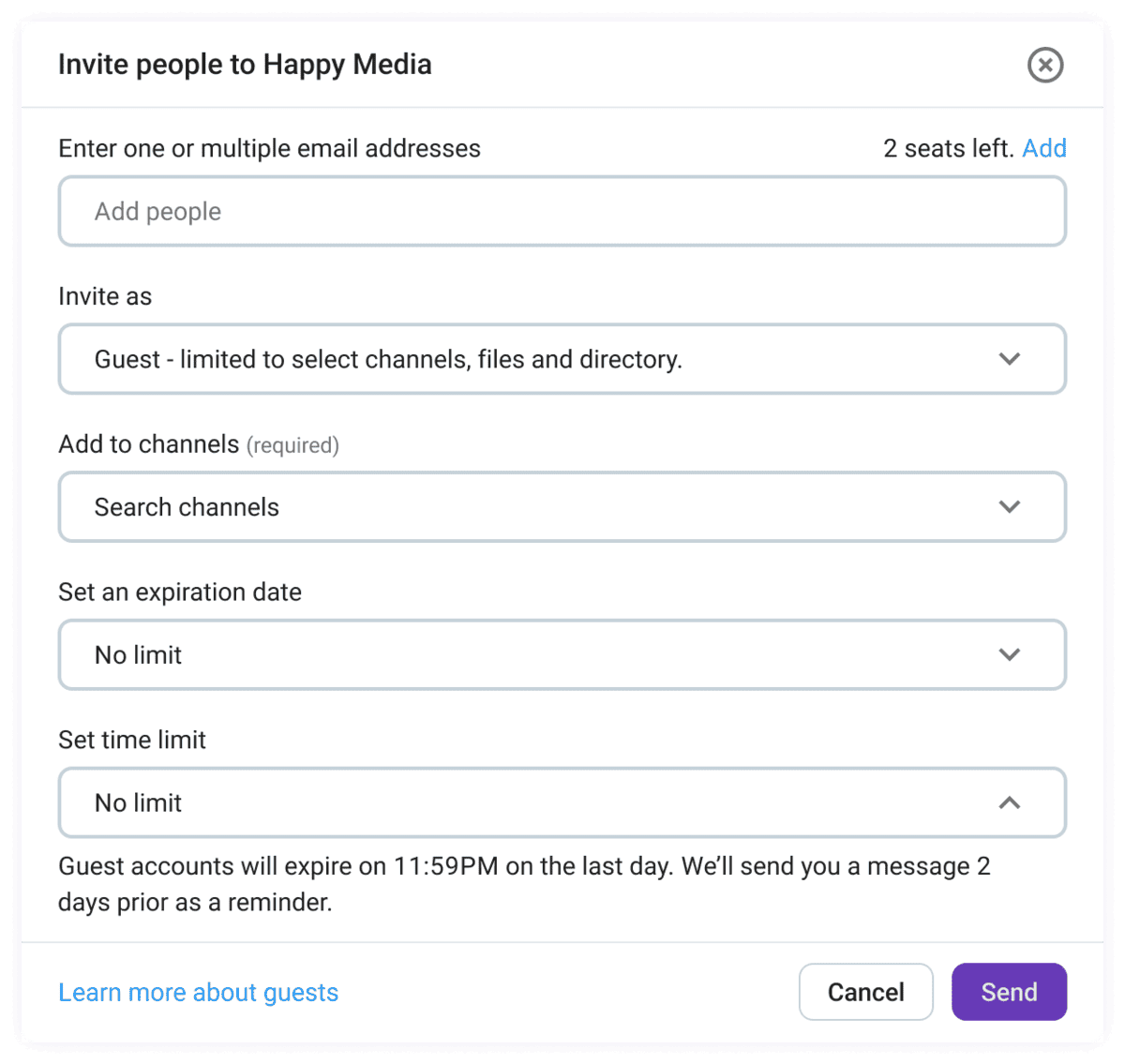
Chanty may be a dash more generous with guest access, but Pumble gives you more customization. Namely, you can set an expiration date for time-limited collaborations. Once the specified date comes around, the guest access will automatically expire and keep your info locked tight.
For this Pumble vs Chanty round, you’ll have to weigh the pros and cons. If you work with the occasional external collaborator, Chanty can handle that pressure. However, small to mid-size businesses looking to bring in more contractors or clients will have more use of Pumble.
💡 PUMBLE PRO TIP
To learn how you can leverage this Pumble feature to your advantage, see this post:
Pumble vs Chanty: Pumble follows strict security protocols
Unless you use a secure business messaging app, it’s only a matter of time until the wrong people get their hands on your money and data. Fortunately, that’s something neither Pumble nor Chanty users have to worry about.
Whenever I logged into Chanty, the app would send me a unique passcode I had to enter before rejoining my workspace. If you’ve ever forgotten your password, this is a much safer and convenient option.

Chanty bolsters security using forward secrecy and AES-128-GCM encryption.Thanks to forward secrecy, information exchanged before a vulnerability incident stays safe and untouched. With past conversations secure, the AES-128-GCM encryption ensures that data being transmitted in the moment remains unchanged.
My only issue with Chanty’s security measures was the data centers. They adhere to the outdated SAS 70 standard, which is generally less secure than the newer SOC 1 and 2 frameworks.
Pumble, on the other hand, has SOC 2 certification, meaning it adheres to strict security practices to safeguard customer data. Moreover, Pumble boasts ISO/IEC 27001:2013 certification, so users can enjoy enterprise-grade security.
Create a secure workspace in Pumble
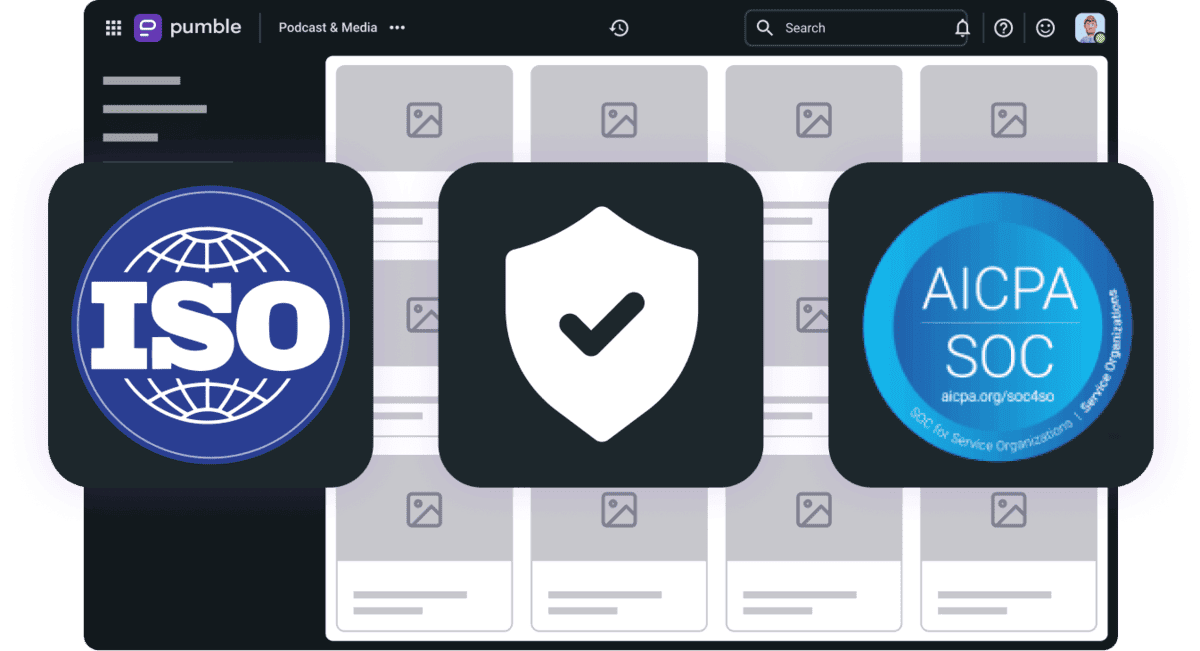
Besides these certifications, Pumble has additional options for users looking for advanced security measures, including:
- Data encryption,
- Custom data retention, and
- Detailed roles and permissions.
Chanty hasn’t had any major privacy breaches, but newer, more rigid security standards would personally give me peace of mind. Taking all of this into consideration, Pumble gets extra points as the collaboration tool with top-notch security.
Make the switch to Pumble
Finding a communication tool that will stick is hard. Not only does it need to help you do more productive work, it should also:
- Provide a better virtual experience for multiple teams,
- Help organizations cut costs, and
- Offer a robust feature set that accommodates growing businesses.
Chanty is a good entry-level app, but the solid features might not make up for the 5-person limit on the free plan.
However, Pumble meets (and exceeds) all the criteria we’ve listed. By using one comprehensive app, you can:
- Send messages with no restrictions,
- Invite new users without having to empty out your pockets for an upgrade, and
- Host video and voice calls.
Pumble is the smart choice for modern teams, whether you’ve just landed your first big client or are thinking of scaling your operations.
Redesign the way you work and try Pumble by CAKE.com today.




